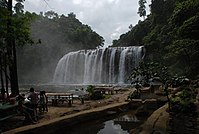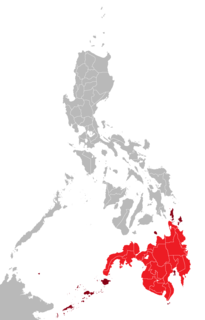
Mindanao is the second-largest island in the Philippines, after Luzon and seventh-most populous island in the world. Located in the southern region of the archipelago, the island is part of an island group of the same name that also includes its adjacent islands, notably the Sulu Archipelago. According to the 2020 census, Mindanao has a population of 26,252,442 people, while the entire island group has an estimated population of 27,021,036 according to the 2021 census.
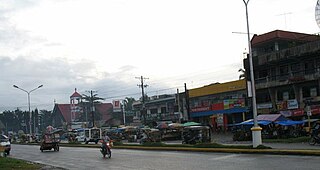
Agusan del Sur, officially the Province of Agusan del Sur, is a province in Caraga region, Mindanao, Philippines. Its capital is the municipality of Prosperidad. It is bordered on the northwest by Agusan del Norte and Misamis Oriental; east by Surigao del Sur; southeast by Davao Oriental; mid-south by Davao de Oro; southwest by Davao del Norte and, mid-west by Bukidnon. It is the fourth largest province in the country in terms of area.

Surigao del Norte is a province in the Philippines located in the Caraga region of Mindanao. The province was formerly under the jurisdiction of Region 10 until 1995. Its capital is Surigao City. The province comprises two major islands—Siargao and Bucas Grande—in the Philippine Sea, plus a small area at the northeastern tip of mainland Mindanao and other surrounding minor islands and islets. This mainland portion borders Agusan del Norte – between the Municipality of Alegria in Surigao del Norte and the Municipality of Kitcharao in Agusan del Norte; and the province of Surigao del Sur, to the south.

Surigao del Sur is a province in the Philippines located in the Caraga region in Mindanao. Its capital is Tandag City. Surigao del Sur is situated at the eastern coast of Mindanao and faces the Philippine Sea to the east.

Caraga, officially the Caraga Administrative Region and designated as Region XIII, is an administrative region in the Philippines occupying the northeastern section of Mindanao. The region was created through Republic Act No. 7901 on February 23, 1995. The region comprises five provinces: Agusan del Norte, Agusan del Sur, Dinagat Islands, Surigao del Norte, and Surigao del Sur; six cities: Bayugan, Bislig, Butuan, Cabadbaran, Surigao and Tandag; 67 municipalities and 1,311 barangays. Butuan, the most urbanized city in Caraga, serves as the regional administrative center.

Tandag, officially known as the City of Tandag, is a 5th class component city and capital of the province of Surigao del Sur, Philippines. According to the 2020 census, it has a population of 62,669 people.
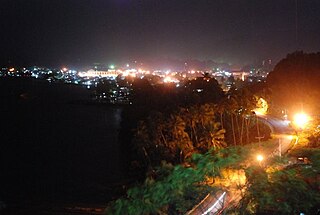
Bislig, officially known as the City of Bislig, is a 3rd class component city in the province of Surigao del Sur, Philippines. According to the 2020 census, it has a population of 99,290 people.
Kamayo, also called Kadi, Kinadi, or Mandaya, is a minor Austronesian language of the central eastern coast of Mindanao in the Philippines.

Cantilan, officially the Municipality of Cantilan, is a 2nd class municipality in the province of Surigao del Sur, Philippines. According to the 2020 census, it has a population of 34,060 people.
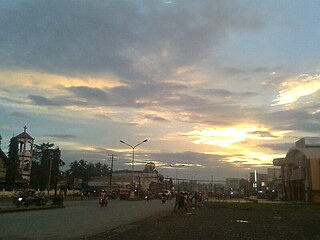
Bayugan, officially known as the City of Bayugan, is a 5th class component city in the province of Agusan del Sur, Philippines. According to the 2020 census, it has a population of 109,499 people. .

Surigao City, officially known as the City of Surigao, is a 3rd class component city and capital of the province of Surigao del Norte, Philippines. According to the 2020 census, it has a population of 171,107 people.

Baganga, officially the Municipality of Baganga, is a 1st class municipality in the province of Davao Oriental, Philippines. According to the 2020 census, it has a population of 58,714 people, making it the third largest town in province.
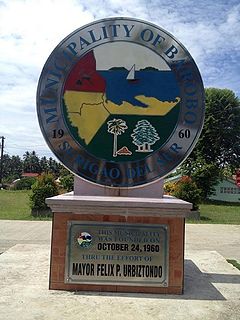
Barobo, officially the Municipality of Barobo, is a 3rd class municipality in the province of Surigao del Sur, Philippines. According to the 2020 census, it has a population of 53,146 people.

Cortes, officially the Municipality of Cortes, is a 4th class municipality in the province of Surigao del Sur, Philippines. According to the 2020 census, it has a population of 17,924 people.

Hinatuan is a second class municipality in the province of Surigao del Sur, Philippines. According to the 2020 census, it has a population of 43,841 people.
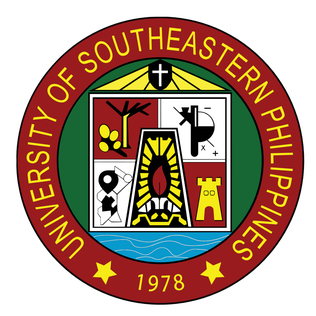
The University of Southeastern Philippines (USeP); Cebuano: Kinatumhaan sa Habagatan Sidlakang Pilipinas, Filipino: Pamantasan ng Timog-Silangang Pilipinas) is a public, research, coeducational, regional state university based in Davao City, Davao del Sur, Philippines. Founded on December 15, 1978, the university is an integration of four state educational institutions: Mindanao State University-Davao, the University of the Philippines-Master of Management Program in Davao, the Davao School of Arts and Trades, and the Davao National Regional Agricultural School. It was the first state university in Davao Region.

The Hinatuan Enchanted River, also called the Hinatuan Sacred River, is a deep spring river on the island of Mindanao in the Philippines. It flows into the Philippine Sea and the Pacific Ocean at Barangay Talisay, Hinatuan, Surigao del Sur. It is found between the boundaries of Barangays of Talisay and Cambatong. It earned the moniker "enchanted river" from the diplomat Modesto Farolan who described the river in his poem entitled "Rio Encantado".

Pinandagatan Falls is located in a far-flung barangay of New Tubigon, Sibagat, Agusan del Sur in the southern Philippine island of Mindanao. It is one of the tourist attractions of Sibagat, Agusan del Sur.
Mount Diwata, also locally unofficially nicknamed Diwalwal, is a remote 1,261-metre (4,137 ft) high range of volcanic mountain and biodiversity area in Davao Region on eastern part of Mindanao island of Philippines. Rich in gold and copper ores and mines, it is spread across the 3 municipalities: (a) Monkayo in the province of Davao de Oro; as well as (b) Cateel and (c) Boston in the province of Davao Oriental. Laguna Copperplate Inscription, the oldest written document in Philippines dated to 900 CE, refers to Mount Diwata.
The Tago River is a stream located in Sibagat, Agusan del Sur, and the municipalities of San Miguel and Tago, Surigao del Sur, Caraga Region, in northeastern Mindanao, in southern Philippines.



